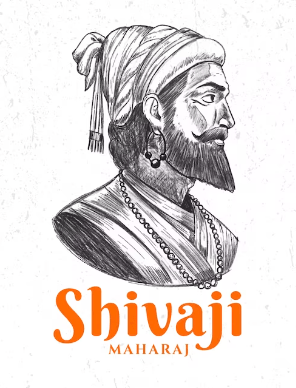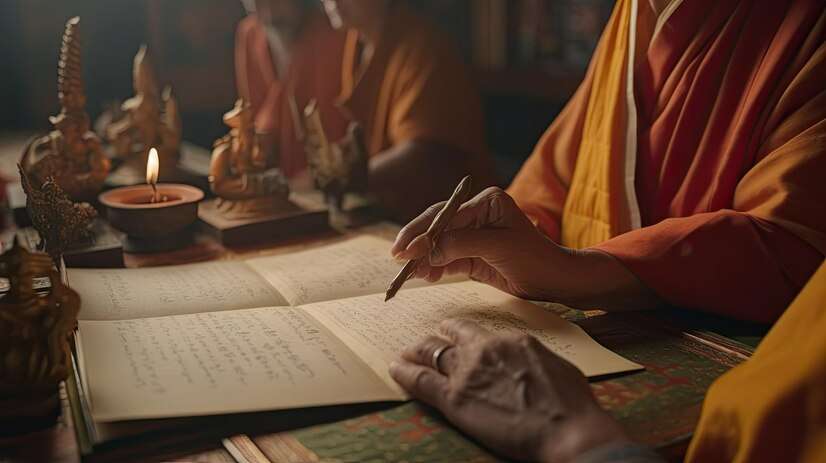TABLE OF CONTENT
ToggleIntroduction to Maratha History
Hello, Mumbai University IDOL students! Today, we’re diving into -“INTRODUCTION TO MARATHA HISTORY” during the period from 1630 CE to 1707 CE. Get ready to explore a variety of sources that unveil the rich tapestry of Maratha history. Let’s break down what we’ll be covering in our discussion.
Firstly, we’ll unravel the Sanskrit sources that provide insights into the history of the Marathas. These ancient texts are like time capsules, offering us a glimpse into the past. Next up, we’ll delve into the significance of Marathi sources. These local perspectives play a crucial role in shaping our understanding of Maratha history.
We’ll explore how the narratives from the Marathi community contribute to the broader historical landscape. Our journey will then take us to the Persian literary sources. These writings shed light on the interactions and influences between the Marathas and the Persian-speaking world. Don’t forget the European sources! We’ll be examining how accounts from European observers contribute to our understanding of Maratha history.
It’s like looking at the story from a different lens. Bakhars , our next stop, are a unique form of historical source. We’ll analyze how these narratives, often poetic and heroic, contribute to our comprehension of Maratha history. Lastly, we’ll critically assess the nature and importance of Marathi sources, questioning their reliability. It’s crucial to understand the strengths and limitations of the materials we use to piece together the past.
So, Mumbai University TYBA IDOL students, get ready to learn about –“INTRODUCTION TO MARATHA HISTORY“ with customized idol notes just for you. Let’s jump into this exploration together.


QUESTION 1:- Discuss the Sanskrit sources for the study of history of Marathas
Introduction:
The study of Maratha history is greatly enriched by the insights provided by Sanskrit sources, offering a window into the culture, society, and political landscape of the Marathas. Among these sources, “Shiv-Bharat,” a Sanskrit poem composed by Shivaji’s court poet Parmananda, stands out as a valuable historical document. This poem, comprised of 31 chapters and nine verses, traces the journey of the Bhosale family from Maloji Bhonsale to Shivaji’s conquest of Shringarpur in 1661. While some scholars, like Jadunath Sarkar, view it as a praise-filled piece, its importance as a contemporary source remains undebatable, providing essential insights into the early history of the Marathas.
-
Shiv-Bharat and the Bhosale Legacy:
- Shiv-Bharat, a creation of Parmananda, plays a pivotal role in unraveling the history of the Bhosale family.
- It spans 31 chapters, presenting a comprehensive account of the family’s journey from Maloji Bhonsale to Shivaji’s significant triumphs, notably the capture of Shringarpur in 1661.
-
Historical Context and Perspective:
- Despite interpretations that label it as a laudatory poem written by a court flatterer, the historical context embedded in Shiv-Bharat makes it a crucial source.
- The poem sheds light on the socio-political milieu of the Maratha Empire during Shivaji’s reign, offering unique perspectives on the challenges and triumphs faced by the Maratha rulers.
-
Comprehensive Understanding through Sanskrit Sources:
- The Sanskrit sources mentioned provide more than just historical narratives; they offer valuable insights into the achievements of Maratha rulers and the socio-political dynamics of their era.
- By studying these texts alongside other historical sources, researchers can develop a well-rounded and comprehensive understanding of the Maratha Empire.
Conclusion:
The Sanskrit sources, with “Shiv-Bharat” at the forefront, significantly contribute to unraveling the tapestry of Maratha history. Despite debates regarding its intent, the historical richness embedded in these sources provides an invaluable resource for scholars and researchers. The study of Maratha history is incomplete without acknowledging the significance of these Sanskrit texts, which offer a glimpse into the vibrant culture, resilient society, and dynamic political landscape of the Marathas.
QUESTION 2 :- Examine the importance of Marathi sources for the study of Maratha history
Introduction:
The study of Maratha history unveils a treasure trove of insights through Marathi sources, offering a window into the culture, society, and political tapestry of the Marathas. Among these sources, Bakhar literature, official documents, and treatises stand out, each providing a unique lens through which we can explore the fascinating journey of the Maratha Empire.
-
Bakhar Literature: A Personal Glimpse into Maratha History
- Bakhar literature, the historical records in Marathi, provides a distinctive perspective on Maratha history.
- While lacking a scientific approach, these narratives offer firsthand accounts of pivotal events, rulers, and societal changes within the Maratha Empire.
- An example is Kashiraj Pandit’s Chronicle of the Battle of Panipat, shedding light on critical historical moments like the Battle of Panipat.
-
Official and Private Documents: A Peek into Administrative Realities
- Marathi sources encompass a wealth of official letters, treaties, engagement records, and private correspondence.
- These documents offer detailed insights into the administrative, political, and diplomatic activities of the Marathas, providing a clear picture of their decision-making processes.
- Peshwa Diaries and family papers, for instance, offer a glimpse into the daily affairs of Maratha rulers and officials.
-
Adnyapatra: Illuminating Shivaji’s Governance
- Written by Ramchandrapant Amatya, Adnyapatra serves as a treatise on polity, delving into the duties of a ruler for the prosperity of the kingdom.
- This document not only sheds light on Shivaji’s career and administration but also provides a deeper understanding of governance, revenue systems, forts, navy, and other facets of Maratha rule.
-
Research and Scholarship: Uncovering Marathi Source Material
- In the late 19th century, scholars like Kashinath Narayan Sane, Vishwanath Kashinath Rajwade, and Govind Sakharam Sardesai played a pivotal role in discovering and analyzing Marathi source material.
- Their efforts led to the exploration of a rich historical trove, significantly contributing to the broader study of Maratha history.
Conclusion:
Marathi sources offer a vibrant and diverse tapestry through which we can unravel the history of the Marathas. From Bakhar literature providing personal narratives to official documents offering administrative insights, these sources are essential in comprehending the dynamics of power, governance, and societal changes within the Maratha Empire. By incorporating these unique perspectives into the broader narrative, historians and researchers can unlock a holistic understanding of Maratha history, earning Marathi sources a deserving place in the study of this fascinating chapter in Indian history.
EXERCISE QUESTIONS :-
QUESTION 1 :- Discuss the importance of Persian literary sources for the study of the history of the Marathas
Introduction:
Delving into the vibrant history of the Marathas requires a nuanced understanding of their interactions with the Mughal Empire, a perspective generously offered by Persian literary sources. These sources, ranging from Mughal court histories to dispatches and news letters, provide a crucial lens through which we can unravel the intricate political landscape of the Indian subcontinent during the Maratha era.
-
Mughal Perspective: Unveiling Diplomacy and Alliances
- Persian sources give us a unique peek into Maratha history from the viewpoint of Mughal rulers and court historians.
- Histories of Mughal emperors, dispatches of officials like Jaisingh, and noble correspondences offer insights into the diplomatic relations, conflicts, and alliances between the Mughals and the Marathas.
- By studying these accounts, historians can decipher how the Mughals perceived and interacted with the Marathas, enriching our understanding of the broader political dynamics.
-
Akhbarat: Narrating Historical Events with Precision
- Persian news letters, known as Akhbarat, emerge as valuable sources providing detailed accounts of historical events, dates, and incidents.
- Preserved in archives in Jaipur and London, these documents offer a wealth of information on political developments, military campaigns, and court intrigues during the Mughal-Maratha interactions.
- By analyzing Akhbarat and other Persian sources, researchers can construct a more accurate and nuanced narrative of Maratha-Mughal relations.
-
Battle of Panipat: Insights into Maratha Military Tactics
- Kashiraj Pandit’s Chronicle of the Battle of Panipat, written in Persian and later translated into Marathi, stands as a reliable account of this pivotal event.
- This source provides valuable details about military strategies, key players, and outcomes of the battle, offering insights into Maratha military tactics and the broader implications of this significant historical episode.
-
Historical Context: Placing Maratha History in the Larger Framework
- Persian sources offer a broader historical context for understanding the Maratha Empire within the larger canvas of Indian history.
- By examining Persian accounts of political events, social dynamics, and cultural exchanges during the Mughal-Maratha period, researchers can develop a more comprehensive understanding of the complexities and nuances of Maratha history.
Conclusion:
Persian literary sources serve as indispensable windows into the history of the Marathas, enriching our understanding of their interactions with the Mughal Empire and their broader impact on the historical narrative of India. From diplomatic intricacies to precise historical events, Persian sources offer a wealth of insights that contribute significantly to our appreciation of the vibrant tapestry that is Maratha history.
QUESTION 2 :- Point out the significance of European sources in the study of Maratha History
Introduction:
The exploration of Maratha history takes on a richer hue when we consider the invaluable contributions of European sources. These accounts, penned by travelers, diplomats, and historians from Europe, provide a unique lens through which we can unravel the intricate interactions between the Marathas and European powers. From political observations to insights into military campaigns, cultural exchanges, and historical narratives, European sources offer a diverse tapestry that enhances our understanding of the Maratha Empire.
-
Political Observations: Unveiling Court Intrigues and Diplomacy
- European travelers and administrators who ventured into India during the Maratha period documented their experiences and observations in letters, diaries, and historical accounts.
- These sources provide a distinct perspective on the political landscape of the Maratha Empire, shedding light on power structures, court intrigues, and diplomatic relations with European powers such as the British, French, Dutch, Portuguese, and Italians.
- The narratives contribute to a more nuanced understanding of the complex political dynamics within the Maratha Empire.
-
Military Campaigns: Detailed Accounts of Maratha Military Prowess
- European sources offer detailed accounts of Maratha military campaigns, strategies, and engagements.
- Observations on battles, sieges, and military tactics recorded by European witnesses provide valuable information on Maratha military prowess, leadership, and the impact of warfare on the region.
- These accounts become essential in constructing a comprehensive narrative of the military history of the Marathas and their interactions with European military forces.
-
Cultural Exchanges: A Glimpse into Maratha Society
- European sources document cultural exchanges between the Marathas and European communities, revealing aspects of trade, commerce, art, architecture, and social interactions.
- Descriptions of Maratha court ceremonies, festivals, and daily life by European travelers offer insights into the cultural richness and diversity of the Maratha society.
- The accounts also highlight the reciprocal influence of European customs and practices on Maratha culture, providing a fascinating glimpse into the dynamics of cultural assimilation.
-
Historical Narratives: Synthesizing Maratha History
- European historians and scholars, including Edward Scott Waring and Grant Duff, have penned comprehensive histories of the Marathas.
- Drawing from a variety of sources, including Marathi documents, court histories, and state papers, these European-authored histories offer synthesized accounts of Maratha political developments, social changes, and military conflicts.
- Such narratives provide a broader perspective on the rise and fall of the Maratha Empire, weaving together diverse strands of historical insight.
Conclusion:
European sources emerge as invaluable companions in the study of Maratha history. From unraveling political intrigues and military campaigns to documenting cultural exchanges and synthesizing historical narratives, these accounts enrich our understanding of the Maratha Empire. By offering diverse perspectives, detailed accounts, and historical context, European sources contribute significantly to our appreciation of the dynamic tapestry that is Maratha history within the broader historical narrative of India.
QUESTION 3 :- Examine Bakhars as a source for the study of the history of Marathas
Introduction:
Delving into the captivating history of the Marathas is a journey enriched by the invaluable contribution of Bakhars. These historical records, penned by contemporaries who witnessed the events they narrated, serve as primary sources, offering a direct link to the past. In exploring their significance, we find that Bakhars provide not only diverse content but also valuable insights into the political, social, and cultural facets of the Maratha Empire.
-
Primary Source Material: A Window to the Past
- Bakhars stand as primary sources, authored by those who lived through the Maratha period, offering firsthand accounts of historical figures, events, battles, and administrative policies.
- These accounts provide authentic details that form a crucial foundation for understanding the Maratha Empire, creating a direct connection with the people and moments that shaped its history.
-
Diverse Content: Exploring the Tapestry of Maratha Society
- Bakhars cover a wide array of topics, ranging from biographies of rulers and family histories to autobiographies, major landmarks, and specific periods or places.
- This diversity allows historians to explore various facets of Maratha society, politics, and culture through different lenses, enabling a comprehensive view of the Maratha Empire and its evolution over time.
-
Historical Context: Unraveling the Dynamics of Maratha Period
- Bakhars not only narrate events but also offer insights into the historical context in which they were written, reflecting the social norms, cultural practices, and political dynamics of the Maratha period.
- By analyzing Bakhars, researchers can gain a deeper understanding of the values, beliefs, and motivations that shaped Maratha society and governance, contributing to a more accurate reconstruction of the historical narrative.
-
Historiographical Challenges: Navigating Reliability and Accuracy
- While Bakhars are invaluable, they come with challenges related to reliability and accuracy. Critics, including Sir Jadunath Sarkar, have pointed out mistakes in Bakhars, attributing them to limitations in the writers and the absence of a scientific approach to historical writing.
- Despite these challenges, Bakhars remain essential for studying Maratha history as they provide a unique and intimate perspective from within the Maratha society.
Conclusion:
Bakhars emerge as indispensable companions in the exploration of Maratha history, offering a direct link to the past, diverse content, insights into historical context, and a glimpse into the challenges of historical interpretation. By critically examining and analyzing these historical records, historians can unfold the story of the Maratha Empire with depth and nuance, shedding light on its complexities and contributions to the vibrant tapestry of Indian history.
QUESTION 4 :- Critically assess the nature and importance of Marathi sources for the study of the history of the Marathas. How far they are reliable?
Introduction:
Embarking on the exploration of Maratha history leads us to a treasure trove of Marathi sources, including Bakhars, letters, diaries, and administrative documents. These sources provide a unique window into the Maratha Empire, offering rich cultural insights, detailed political narratives, and local perspectives. However, as we delve into their nature and importance, it becomes crucial to critically assess their reliability, considering potential biases, accuracy concerns, and the significance of cross-referencing.
Nature and Importance of Marathi Sources:
-
Rich Cultural Insights:
- Marathi sources offer a vibrant portrayal of Maratha society, delving into its language, customs, and traditions.
- These sources provide a nuanced understanding of the cultural fabric of the Maratha Empire, shedding light on its interactions with diverse regions and communities.
-
Political Narratives:
- Marathi sources contain detailed accounts of political narratives, court intrigues, administrative policies, and diplomatic relations of the Maratha rulers.
- They present a comprehensive view of the political landscape, power struggles, and governance structures within the Maratha Empire.
-
Local Perspectives:
- Marathi sources uniquely offer local perspectives on Maratha history, reflecting the experiences, beliefs, and aspirations of the Marathi people.
- These sources highlight regional dynamics, economic activities, and social hierarchies that shaped the Maratha society.
Reliability of Marathi Sources:
-
Challenges of Bias:
- Marathi sources may exhibit biases towards the ruling elite or specific factions within the empire, potentially skewing the representation of historical events.
- Writers often had affiliations with the ruling elite, introducing biases that need careful consideration.
-
Accuracy Concerns:
- The reliability of Marathi sources may be questioned due to potential inaccuracies, exaggerations, or omissions in the narratives.
- Writers might have embellished events or downplayed others to align with their political or personal agendas.
-
Verification Issues:
- Verifying the accuracy of Marathi sources poses challenges, as limited corroborating evidence from other sources may be available.
- Critical analysis and cross-referencing with Persian, European, and other sources become essential to establish reliability.
Importance of Cross-Referencing:
- Enhancing Reliability:
- Historians often cross-reference Marathi sources with diverse perspectives to validate information and mitigate biases and inaccuracies.
- Triangulating information from various sources contributes to a more balanced and nuanced interpretation of Maratha history.
Conclusion:
Marathi sources stand as invaluable windows into the history of the Marathas, offering unique insights and perspectives. However, their reliability necessitates a critical evaluation due to potential biases and accuracy concerns. By approaching Marathi sources with a discerning eye and employing cross-referencing techniques, historians can extract valuable insights, construct a more accurate narrative of the Maratha Empire, and appreciate its enduring legacy in Indian history.
IMPORTANT QUESTIONS :-
- Discuss the Sanskrit sources for the study of history of Marathas
- Point out the significance of European sources in the study of Maratha History
- Examine Bakhars as a source for the study of the history of Marathas Critically assess the nature and importance of Marathi sources for the
- Study of the history of the Marathas. How far they are reliable?
Important Note for Students:- These questions are crucial for your preparation, offering insights into exam patterns. Yet, remember to explore beyond for a comprehensive understanding.
